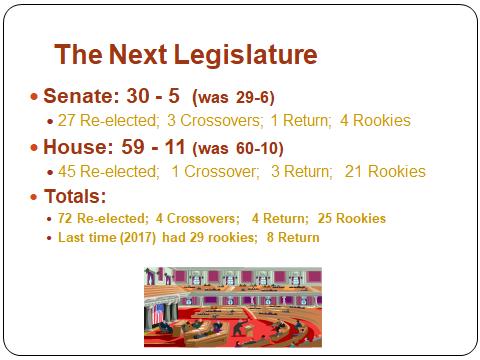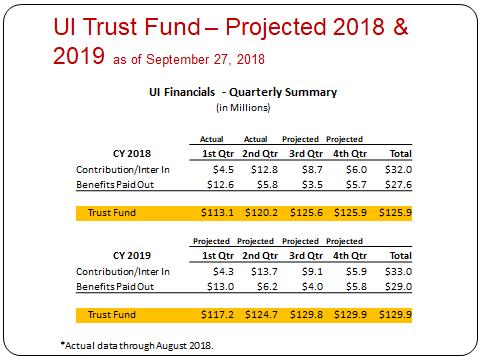|
January 11, 2019
It’s the same old thing in a brand new way.
There are events that occur on an annual basis for people living on the high plains; blistering heat, horrid humidity, blinding blizzards and, of course, legislative sessions.
This annual legislative session is new in a most significant aspect. To use an old quote “there’s a new sheriff in town” . . . new leadership and with her an attitude that is eager to face the future head on and ready to do hard work now so that future generations of legislators and citizens can enjoy a well-run and prosperous state when it’s their turn to face the blistering heat and blinding blizzards of future legislative sessions.
Moving beyond the routine expressions of lament about the beginning of the 2019 Legislative Session, the South Dakota Chamber of Commerce and Industry appreciates the dedication and service of both legislators and the public servants that will work with the new administration to face the needs of delivering services. The leadership of Chamber appreciates the number of difficult decisions that await and the hard work to find workable solutions to those issues.
The South Dakota Chamber of Commerce and Industry understands that a free-market economy depends on government to provide services that are essential for business including the rule of law, an educated workforce, and the necessary infrastructure of roads, water and sewer treatment and, in many areas, the underpinnings of the quality of life enjoyed throughout South Dakota.
Thank you for choosing public service. Now, there are new bills being proposed – time to get to work.
The 2019 Legislature by the numbers.
Below is a slide from the pre-session informational tour conducted by the South Dakota Chamber of Commerce and Industry which shows the partisan divide and how many legislators are serving in their very first session (answer = 29).

What do Legislators DO?
South Dakota uses citizen legislators who put down their everyday jobs and endeavors to face the daunting decisions about the state for 40 days and then return to their livelihoods and await judgement on the decisions they made in the frozen and darkened days of winter.
What the heck do they do as part of being in their normal lives? Because there is nothing normal about spending 40 days in Pierre in the dead of winter. Which leads one is to ponder the coincidence of legislative sessions lasting exactly as long as Jesus spent in the wilderness and the same number of days that it took to flood the entire earth . . . but we digress.
Based on the information legislators provide as part of their profile in the Legislative Handbook, here is a basic look at the jobs and careers of the legislators.
The largest block of people in the legislature is people with business backgrounds. There are 42 of the 105 that list business and their occupation. This includes 14 people who listed themselves as “business owners”, 7 from insurance/financial services, 5 contractors, 3 realtors, 2 CPAs, and 5 consultants.
The next largest group is people who are retired with a total of 19 including: 4 bankers, a lawyer and a judge, a dentist and 4 folks from the military or law enforcement.
Agriculture is third with 17 listing farming or ranching as their primary job. These legislators include two ranchers, seven farmers, plus three that list both kinds of operations and five that list farming/ranching along with some business enterprise.
The legal community takes up 4th place with seven (but they are likely to appeal that status trying to include the retired judge and a retired lawyer).
The rest of the list includes: Healthcare with five, non-profit organization work with five, consultants with five and educators with four.
An examination of the listings shows that approximately eight legislators are public employees working for school districts, or higher education.
Here is the summary in list form:
- Business – 47
- Retired – 19
-
Agriculture – 17
-
Legal – 7
-
Health Care – 5
-
Non-profit organizations – 5
-
Education – 5
An early bill that brings good news.
HB 1034 – Regarding unemployment insurance (UI) contribution rates.
Straight to point – UI rates will be reduced in 2020 because there are ample funds in the UI Trust Fund. Two years ago, the legislature adopted a policy that updated the age old question about how much money should South Dakota keep in the UI Trust Fund and when should the system say “enough”.
Worrying about trust fund levels became real during the great recession when the UI system went from paying out $25-30 million a year which is common during a healthy economy (see chart below), to paying out more than $67 million in one year during the first year of that recession. The former calculation was that $78 million was plenty; which proved to be plenty wrong.
The new policy sets the trust fund goal at a level of roughly 160% of the state’s average payout during the worst three recessions. The chart below shows the trust fund ended up with $125 million at the end of 2018 and is expected to have $129 million at the end of this year.

A future issue of Capitol-ism will discuss the amount of the “contribution” reduction”.
Which bring about a final observation. Paying into the unemployment trust fund isn’t considered a tax but rather a “contribution” and is one small example of a distinction without a difference.
Business Day at the Legislature is set for Thursday, February 21, 2019. Click here for event details.
Thank you for your support of the South Dakota Chamber of Commerce & Industry.
|